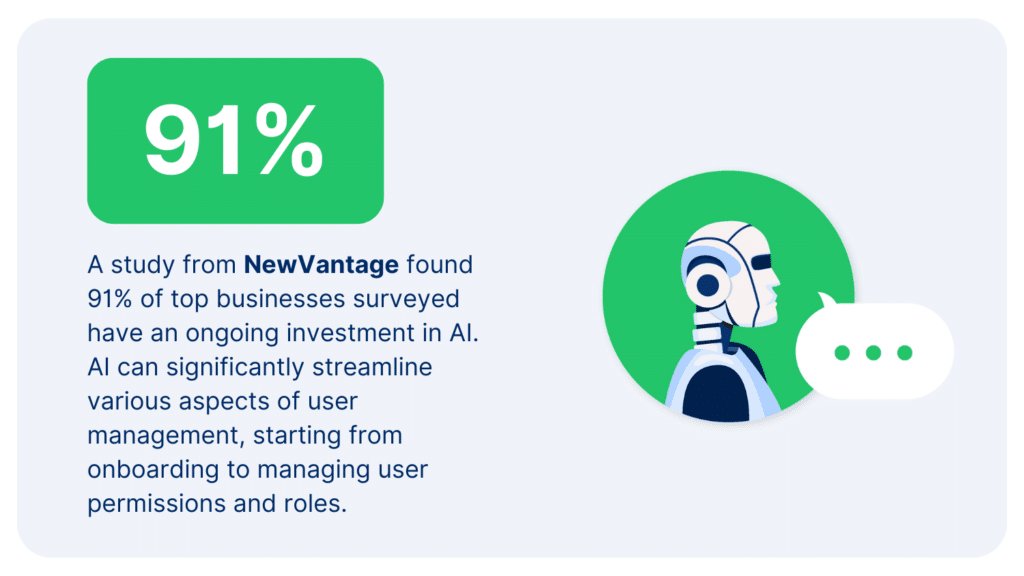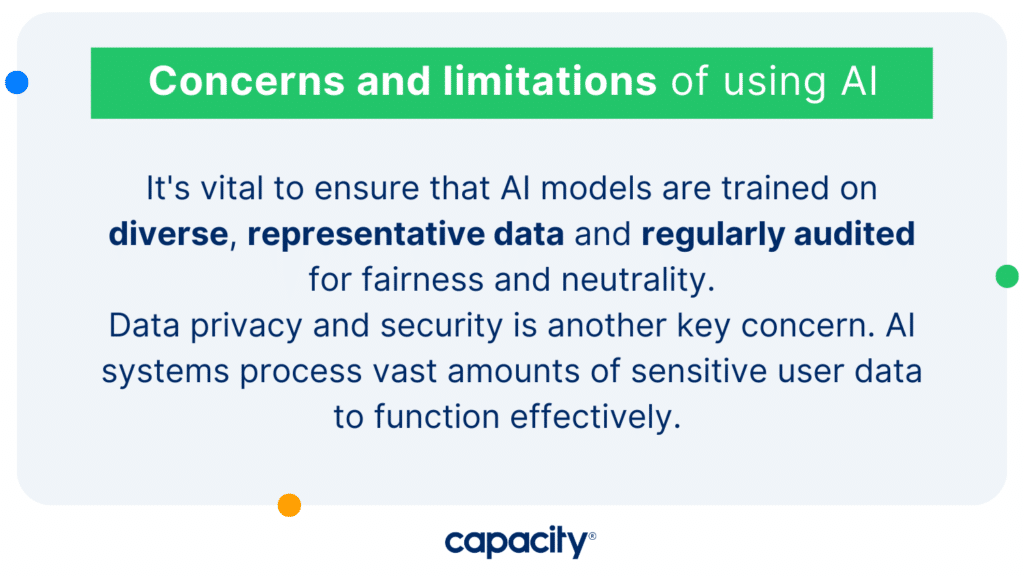Picture this: You’re a system admin for a bustling international corporation. You have to juggle the management of thousands of user accounts across several continents. And each one has distinct access needs and privileges. You’re on your third coffee, and it’s only 10 a.m. Now, imagine if there was a way to simplify this daunting task. What if you could make user management and role-based access control (RBAC) as effortless as making a cup of coffee? Welcome to the world where Artificial Intelligence (AI) like ChatGPT revolutionizes how we navigate the complex realm of user management and role-based access control.
User management refers to the administrative process of adding, removing, and maintaining user accounts within a system or network. It’s the bedrock of secure digital ecosystems, and it includes the pivotal task of defining and managing user roles and access permissions. This is known as Role-Based Access Control or RBAC. RBAC is the system that ensures John from accounting doesn’t accidentally stumble into the company’s confidential strategic plans. Or, it ensures that the new intern doesn’t find themselves amidst complex financial transactions.

Automate Your Work
Capacity’s enterprise AI chatbot can help:
- Answer FAQs anytime, anywhere
- Find relevant documents within seconds
- Give surveys and collect feedback
In recent years, AI, with intelligent systems like ChatGPT, is making an entrance into various domains. From healthcare to finance to education, it’s transforming the way we operate. So, it’s no surprise that AI’s potential to bring changes to user management and RBAC is now a hot topic. But the question remains: Will User Management and Role-Based Access Control Get Better with ChatGPT? Let’s dive in and explore.
Understanding user management and role-based access control

User management refers to the process of creating, managing, and controlling user accounts and their associated permissions within an organization’s systems and applications. It involves tasks such as user provisioning, authentication, authorization, and account maintenance. User management ensures that the right individuals can access appropriate resources and data based on their roles and responsibilities.
Role-Based Access Control (RBAC) is a method of access control that assigns permissions and privileges to users based on their roles within an organization. Instead of granting permissions directly to individual users, RBAC defines roles with associated permissions and assigns users to those roles. This approach then simplifies access control administration by managing permissions at a role level rather than on a per-user basis. RBAC enables organizations to enforce the principle of least privilege. Basically, it ensures that users only have access to the resources necessary to perform their job functions.
Why you need user management and RBAC
Effective user management and RBAC are crucial for maintaining a secure and well-controlled environment. RBAC helps to limit user access rights. This then prevents unauthorized actions and separation of duties, distributing critical tasks among multiple users to prevent fraud or abuse. When you implement proper user management practices and RBAC, your company can minimize the risk of data breaches and threats.
Traditional systems often face challenges in user management and access control. Manual user account creation and maintenance processes can be time-consuming, error-prone, and difficult to scale. Ad hoc permission assignments may result in inconsistent access control, leading to security vulnerabilities. Furthermore, managing user access across multiple systems and applications can be complex. When it comes to granting or revoking access for users who change roles or leave the organization, things get sticky. However, these challenges highlight the need for robust user management systems with RBAC capabilities. With them, streamline processes, enhance security, and ensure proper access control across your organization’s infrastructure.
What’s the potential of AI in user management?

AI, like ChatGPT, holds immense potential in user management, a key component of many businesses and organizations. A study from NewVantage found 91% of top businesses surveyed have an ongoing investment in AI. AI can significantly streamline various aspects of user management. From onboarding to managing user permissions and roles, predicting user behavior, and even identifying potential risks or security threats, AI can help.
Firstly, ChatGPT can automate the process of user onboarding and offboarding, thus reducing manual effort and the likelihood of errors. It can manage and update user roles, access permissions, and security protocols. Then, you can ensure that the right people can access the right resources at the right time. Secondly, with ChatGPT’s ability to analyze vast quantities of data, businesses can understand user behaviors and preferences better. Ultimately, this leads to more personalized and effective user experiences. Predictive analysis can also forecast future behavior, helping in proactive planning and decision-making. Furthermore, ChatGPT can detect abnormal user behavior or patterns that may signify potential security threats, enhancing overall system security. In short, integrating ChatGPT into user management can lead to efficiency, security, and a more personalized and proactive approach.
Using AI like ChatGPT for user management and role-based access control
AI, specifically intelligent systems like ChatGPT, has vast potential in user management and role-based access control. One important use case is intelligent user authentication. By incorporating various AI techniques such as pattern recognition, machine learning, and biometric identification, the authentication process can be significantly enhanced. In the end, the process becomes both user-friendly and more secure. For instance, AI could analyze patterns in user login times, locations, and devices to add an extra layer of validation to traditional password-based systems. Thus, it helps reduce the chances of unauthorized access.
In addition, ChatGPT can also be used for dynamic role assignment and policy management. As the responsibilities and requirements of users can fluctuate over time, it’s important for access controls to reflect these changes promptly and accurately. AI can learn from user behavior, job changes, and context. Then, it dynamically adjusts user roles and access permissions. In effect, it ensures only the necessary access is granted and security risks are minimized.
Automated user activity monitoring and anomaly detection are other key benefits ChatGPT brings to user management. Machine learning algorithms can monitor user activities continuously, detect unusual behavior, and raise alerts in real-time. This could be anything from detecting an abnormal bulk download of sensitive documents to spotting a login attempt from an unusual location. These alerts provide an extra layer of security to the system. These AI-enabled systems can thus transform user management from a static, manual process to a dynamic, automated, and highly secure one.
Concerns and limitations of using AI for user management and RBAC

While the potential of ChatGPT in user management and role-based access control (RBAC) is immense, there are several concerns and limitations that need to be addressed. Ethical considerations are at the forefront, especially when AI systems are given the ability to make decisions that affect user access and privileges. An algorithm that is biased or discriminatory could unfairly restrict access or grant undue privileges, leading to potential misuse. Therefore, it’s vital to ensure that AI models are trained on diverse, representative data and regularly audited for fairness and neutrality.
Data privacy and security is another key concern. AI systems process vast amounts of sensitive user data to function effectively, which raises questions about data storage, handling, and potential misuse. It’s crucial to establish strong encryption and data anonymization practices and comply with data protection laws to maintain user trust. Furthermore, while automation can greatly enhance efficiency, it must be balanced with human oversight. It’s important to have humans in the loop to review critical AI decisions, especially in areas like user access to sensitive resources, to ensure the system doesn’t overstep its bounds or make harmful errors. Ultimately, the benefits of ChatGPT in user management and RBAC must be carefully weighed against these ethical, privacy, and oversight concerns to develop an effective and trustworthy system.
Looking forward: What’s the future of AI and ChatGPT for user management and role-based access control?

The future of AI and tools like ChatGPT for user management and role-based access control (RBAC) is rich with possibilities as new advancements and emerging trends continue to redefine the landscape. One anticipated trend is the increasing integration of AI with other transformative technologies like blockchain and IoT. Blockchain can enhance data security and transparency in AI user management, while IoT can increase the scope and complexity of access controls as more devices become internet-enabled.
Real-time and predictive user management is another potential advancement. AI could use real-time data and predictive analytics to anticipate user needs and adjust access controls even before they’re required, leading to improved efficiency and user satisfaction. Additionally, the use of AI in RBAC could become more nuanced, with access controls that vary based on factors like time, location, and the nature of the request.
However, there are challenges on the horizon too. As AI becomes more integral to user management, there is a risk of over-reliance on these systems and underestimation of potential failures or malicious attacks. It’s also crucial to address potential bias in AI systems, which could lead to unfair access controls. Further, as AI and RBAC systems become more complex, there will be an increased need for transparency and explainability.
The roadmap for the future
A rough roadmap for the future could start with increasing awareness and education about the possibilities and challenges of AI in user management. Next would be developing robust standards and ethical guidelines for AI use in RBAC. Also crucial is the continuous auditing and refinement of AI models for bias and fairness, along with strong data privacy and security measures. Looking further ahead, developing more advanced AI systems that can handle real-time, predictive, and nuanced access controls and integrating AI with technologies like blockchain and IoT can lead to a future where AI plays a vital role in secure, efficient, and user-friendly access management.
The ultimate question remains: Will User Management and Role-Based Access Control Get Better with AI? While we cannot predict the future completely, the potential and advancements we’ve explored suggest a positive outlook. The journey towards using ChatGPT in user management and RBAC is well underway, promising to bring more security, efficiency, and personalization. As system administrators, organizations, and users, it’s our collective responsibility to navigate this journey wisely, ensuring a future where technology serves us better without compromising our values and rights. Let’s embrace this exciting journey together, navigating the challenges and shaping a future where managing thousands of user accounts feels as effortless as making a cup of coffee. Here’s to a future powered by AI, a future that’s secure, efficient, and remarkably user-friendly.

Automate Your Work
Capacity’s enterprise AI chatbot can help:
- Answer FAQs anytime, anywhere
- Find relevant documents within seconds
- Give surveys and collect feedback





